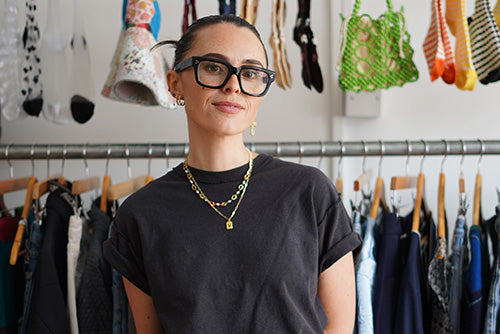Altina Schinasi Miranda & The Harlequin Frame

When designing Södermalm, we poured ourselves over an archive of eyewear inspiration, and in doing so, we came across the story of a remarkable woman.
Altina Schinasi Miranda, was a multimedia artist, window dresser, film-maker, activist, and last but not least, the designer of the Harlequin frame.
At a time when eyewear was largely seen as a functional necessity and the styles were geared towards men, Altina changed the game with her Venetian mask-inspired eyewear - the blueprint for the modern cat-eye frame. But there’s much more to Altina's story, so let’s start at the beginning…
THE WOMAN BEHIND THE FRAME
Born in 1907, Manhattan, New York, to immigrant parents of Salonica and Sephardic Jewish Turk descent, Altina grew up in a culturally diverse environment, the inspiration of which can be felt in her later artistic work.
Her family had humble beginnings but gained a sizeable fortune from her fathers patented invention of a cigaret-rolling machine. This fortune gave her financial freedom to pursue her love of art, and after graduating high school, Altina briefly moved to Paris to study painting before returning to the US in the 1930’s where she went on to study art at the The Art Students League in New York. It was at the The Art Students League that she first became acquainted with German Artist George Grosz who’s life and work she would eventually produce an award winning documentary about.
Around the same time, Altina began working with Peter Copeland, designing windows for Fifth Avenue stores. During her time with Peter, Altina worked alongside surrealist Salvador Dali on window displays for Bonwit Teller.
Unfortunately the window display was not well received and when management tried to change it, Salvador Dali put up quite the protest which resulted in a smashed window. His original window designer were not used and only designs inspired by Dali's work.

DESIGNING THE HARLEQUIN
Walking down 5th avenue, studying the displays, Altina came across an opticians and was struck by how overwhelmingly reserved and masculine the styles were.
This prompted her to designed her first frame, the Harlequin.
“I passed the shop of an optician and I saw this oil painting of glasses glued onto the face, and I thought, That is really so ugly! And then Dorothy Parker was writing verses, 'Men never make passes at girls that wear glasses', and I thought, well something better could be done than just these awful glasses that look like the time of Benjamin Franklin. And I said, What would be good on my face? I thought of a mask. A Harlequin mask. They really appeal to flatter a face.” - Altina Schinasi Miranda

Drawing inspiration from Venetian masks, her new eyewear frame designed specifically for women was fun and theatrical - exaggerating the natural shape of the eye with her unique cat-eye silhouette. The above picture shows Altina's prototypes made from paper.

Initially, her designs got rejected by most retailers until finally, she struck up a partnership with Lugene, an opticians on Madison Avenue.

Clare Boothe Luce, a writer (and later a politician) who at the time was working as an editor for Vogue and Vanity Fair, was among the first to own a pair. With this new connection at Vogue, Altina’s Harlequin glasses soon became all the rage and in 1939 Altina received an American Design Award from Lord & Taylor for the Harlequin design.

The Harlequin style remained extremely popular all the way into the 60's with the help of movie stars such as Marilyn Monroe, who wore a variation of the frame in ‘How to Marry a Millionaire,’ and ‘Gentlemen Prefer Blondes,’ as well as Audery Hepburn, who went on to wear a more contemporary variation in her iconic performance of Miss Holly Golightly. Still to this day, across decades and designers, Altina’s influence can been seen.

ART & ACTIVISM
Shortly after winning her Design Award from Lord & Taylor, Altina retired from the eyewear industry and began focusing her attention towards her other artistic pursuits. One of her most famous series was her “chairacters” - part sculpture, part seat.

In the early 1960’s she began her career in film-making with her documentary film, George Grosz' Interregnum, which centred around the anti-nazi work of George Grosz, the artist she had met earlier on in life at The Art Students League. George Grosz' Interregnum won first place at the Venice Film Festival and was nominated for an Academy Award.
Soon after, Altina found herself drawn to Martin Luther King Jr.'s March on Washington and began working on a documentary film around his march and the civil rights movement. She acquired the film rights and had author John Oliver Killens write the screenplay. Sadly, due to lack of funding the project was not completed.
Until old age, Altina continued her work as an artist and even volunteered as an art therapist. Altina passed away in 1999 at age 92.

HERE’S TO ALTINA
To learn more about this inspirational women, read Altina's autobiography, 'The Road I have Travelled’ or watch the 2014 documentary ‘Altina’ produced by Peter Sanders.


